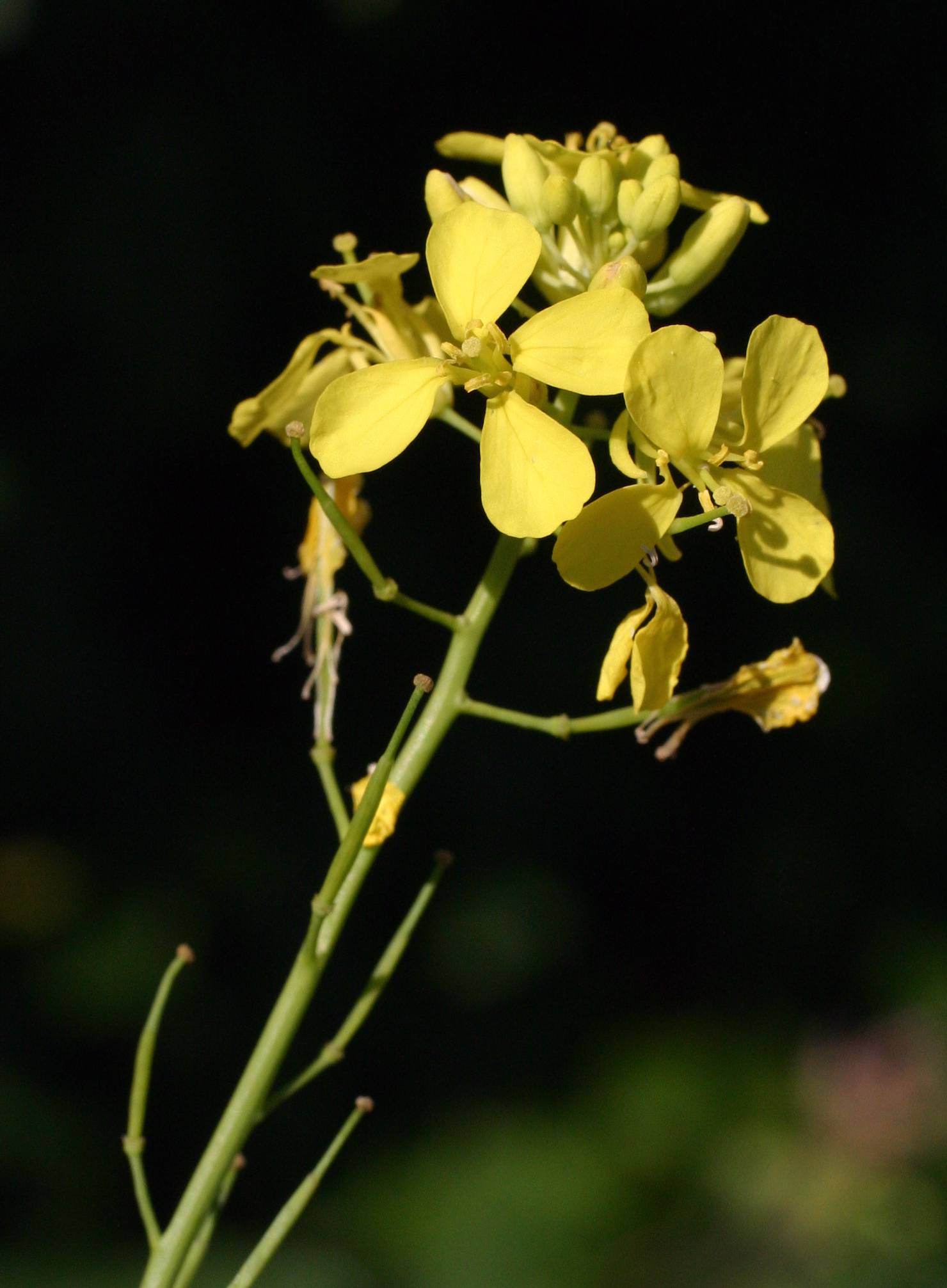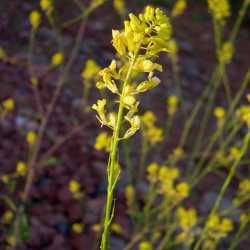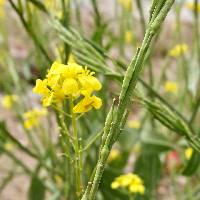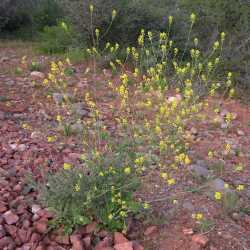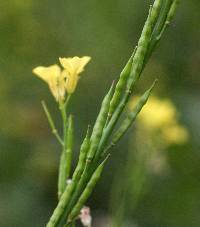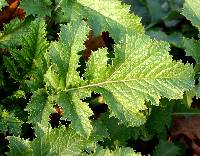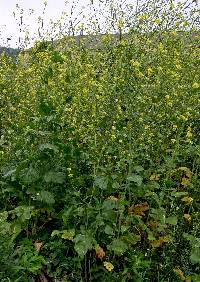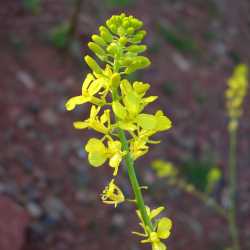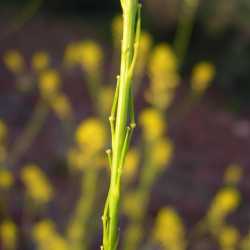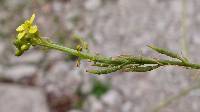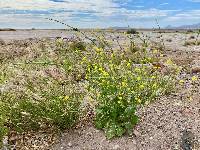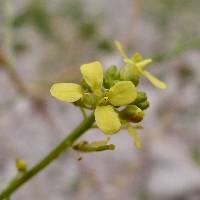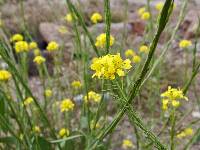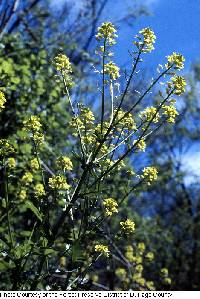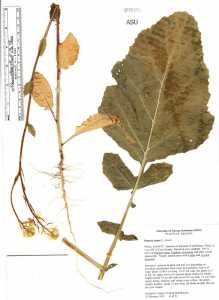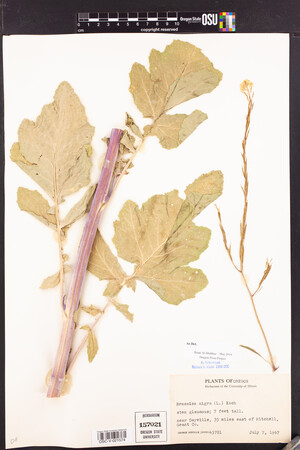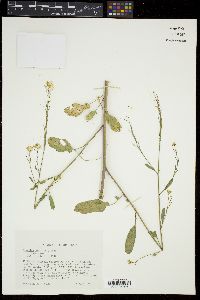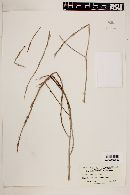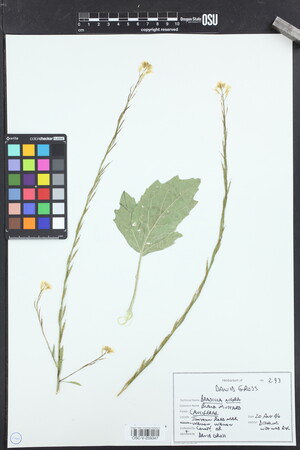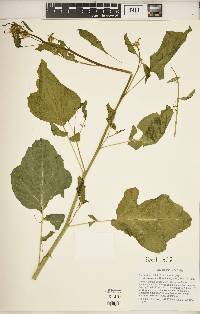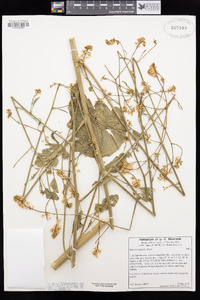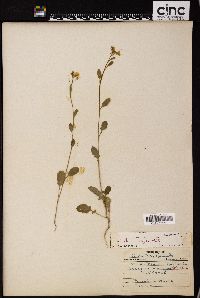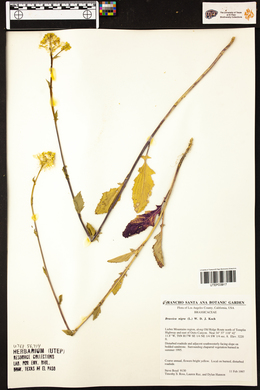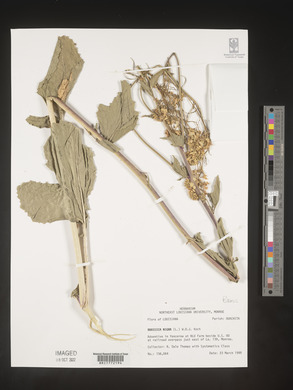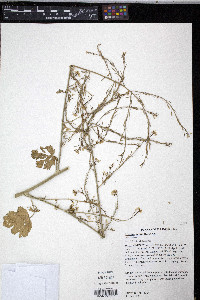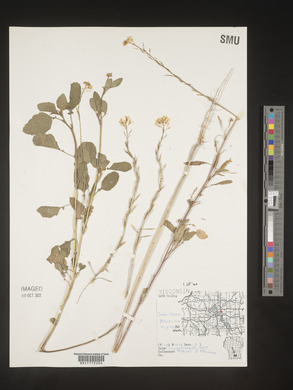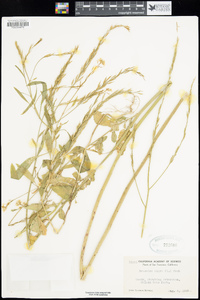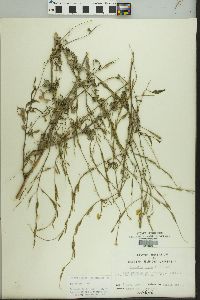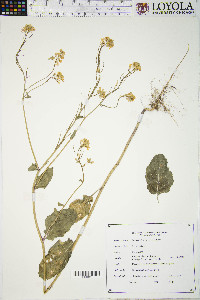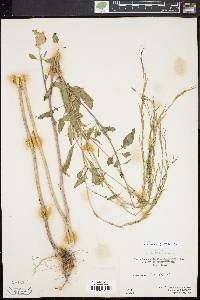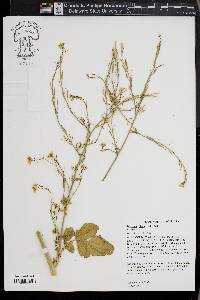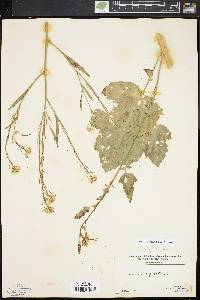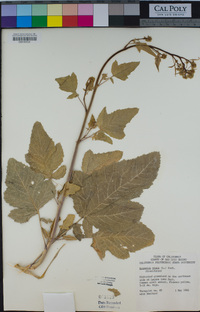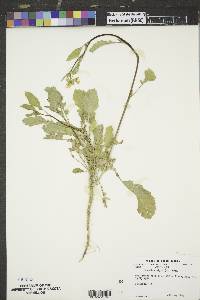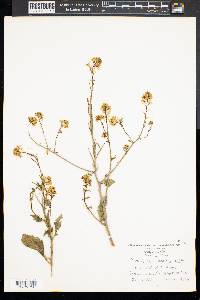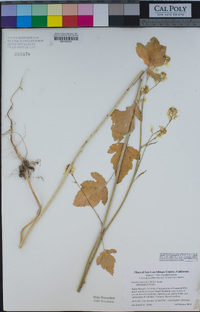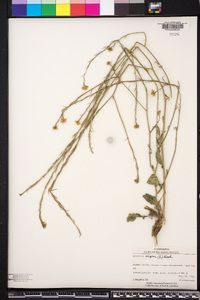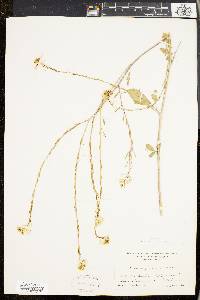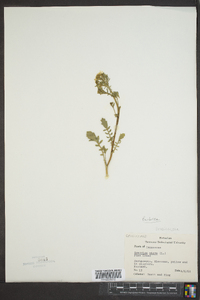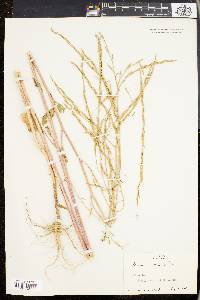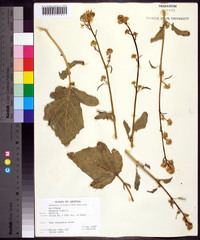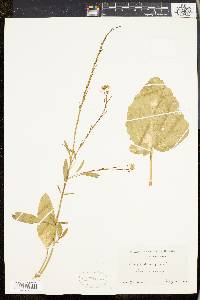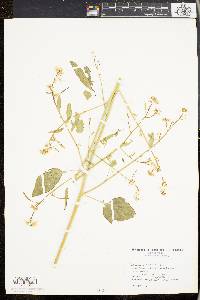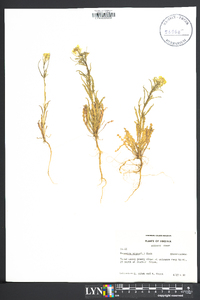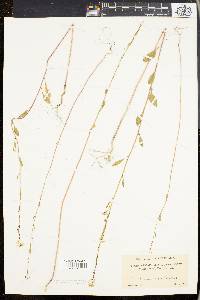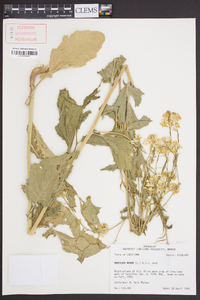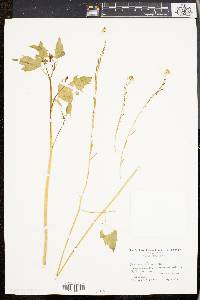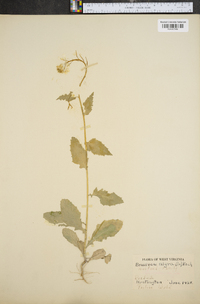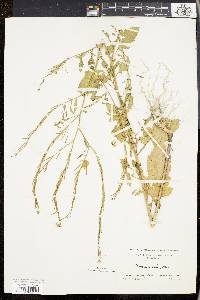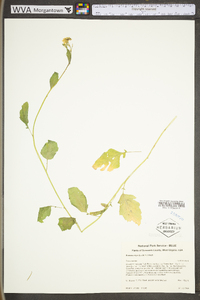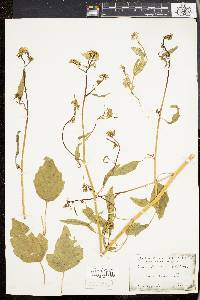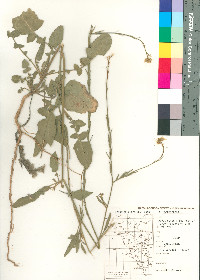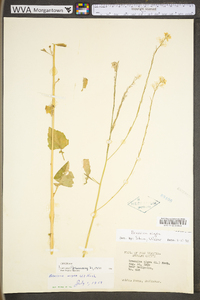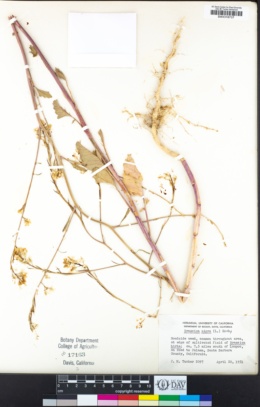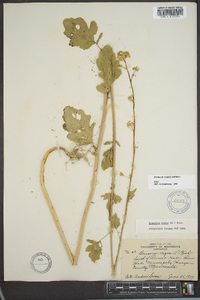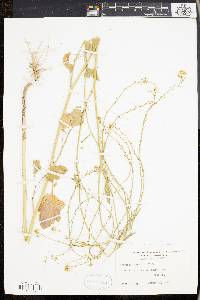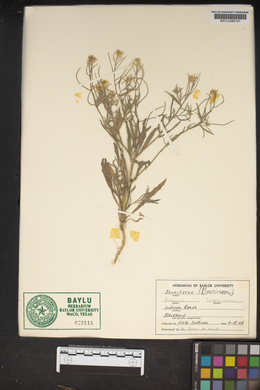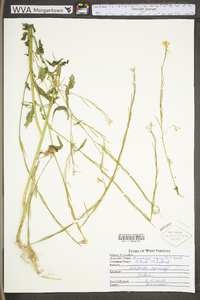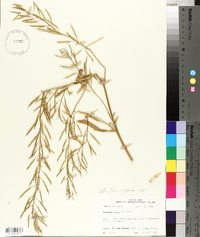
|
|
|
|
Family: Brassicaceae
Black Mustard, more...shortpod mustard (es: mostaza)
[Sinapis nigra L.] |
Annuals; sparsely to densely hirsute-hispid (at least basally, proximally rarely subglabrate). Stems usually branched distally, (widely spreading), 3-20 dm. Basal leaves: petiole to 10 cm; blade lyrate-pinnatifid to sinuate-lobed, 6-30 cm × 10-100 mm, lobes 1-3 each side, (smaller than terminal, terminal lobe ovate, obtuse). Cauline leaves sessile or subsessile; blade (ovate-elliptic to lanceolate, similar to basal, reduced distally and less divided), base tapered, not auriculate or amplexicaul, (margins entire to sinuate-serrate). Racemes not paniculately branched. Fruiting pedicels erect (straight), (2-)3-5(-6) mm. Flowers: sepals 4-6(-7) × 1-1.5 mm; petals yellow, ovate, 7-11(-13) × (2.5-)3-4.5(-5.5) mm, claw 3-6 mm, apex rounded; filaments 3.5-5 mm; anthers 1-1.5 mm. Fruits erect-ascending (± appressed to rachis), smooth, ± 4-angled, 1-2.5(-2.7) cm × (1.5-) 2-3(-4) mm; valvular segment 2-5(-8)-seeded per locule, (0.4-)0.8-2(-2.5) cm, terminal segment seedless (linear, narrow), (1-)2-5(-6) mm. Seeds brown to black, 1.2-1.5(-2) mm diam.; seed coat coarsely reticulate, minutely alveolate, not mucilaginous when wetted. 2n = 16. Flowering Apr-Sep. Roadsides, disturbed areas, waste places, fields, orchards; 0-1500 m; introduced; Alta., B.C., N.B., Nfld. and Labr., N.S., Ont., P.E.I., Que., Sask.; Ala., Alaska, Ariz., Ark., Calif., Colo., Conn., Del., D.C., Fla., Ga., Idaho, Ill., Ind., Iowa, Kans., Ky., La., Maine, Md., Mass., Mich., Minn., Miss., Mo., Mont., Nebr., Nev., N.H., N.J., N.Mex., N.Y., N.C., N.Dak., Ohio, Okla., Oreg., Pa., R.I., S.C., S.Dak., Tenn., Tex., Utah, Vt., Va., Wash., W.Va., Wis., Wyo.; Europe; Asia; Africa; introduced also in Mexico, Central America, South America, Atlantic Islands, Australia. Brassica nigra is widely cultivated as a condiment mustard. It is also a cosmopolitan weed especially common in the valleys of California (R. C. Rollins 1993). It occurs only sporadically in southern Canada but most frequently in Ontario and along the St. Lawrence River. Specimens from Alberta, Arkansas, Delaware, and South Carolina have not been observed.
Annual herb to 2 m tall Stem: upright, hairy toward base, with a waxy coating (glaucous). Flowers: in branched clusters, yellow, to 1 cm wide. Petals four. Stamens six. Fruit: a narrow pod, upright or appressed to the stem, 1 - 2 cm long, four-angled, with an 8 mm long beak. Seeds 1.5 - 2 mm long, brownish black, with about twenty per pod. Lower leaves: alternate, pinnately divided, stalked, not clasping, to 15 cm long, to 6 cm wide, base lobed, toothed, with a waxy coating (glaucous). Upper leaves: alternate, stalked, not clasping, to 6 cm long, to 2 cm wide, lance-shaped to oblong, sometimes toothed, with a waxy coating (glaucous) on the lower surface. Similar species: Brassica nigra and B. juncea are the only two Brassica species in the Chicago Region without leaves that are clasping at the base. Brassica juncea is otherwise similar, but it is hairless and covered with a waxy coating (glaucous). Flowering: mid-May to mid-October Habitat and ecology: Introduced from Eurasia. A common, naturalized weed of dumps, waste ground, roadsides, and cultivated fields. Occurence in the Chicago region: non-native Etymology: Brassica is the Latin word for cabbage. Nigra means black. Author: The Morton Arboretum FNA 2010, Kearney and Peebles 1969 Duration: Annual Nativity: Non-Native Lifeform: Forb/Herb General: Widely spreading annual, glabrous, pedicels appear jointed at the nodes. Leaves: Variable in shape and size, 6-30 cm long, divided to sinuously lobed, margins entire or toothed, cauline leaves sessile, usually increasing in number near the base. Flowers: Bright yellow, bisexual, with 4 sepals and up to 4 petals 7-11 mm, stamens 6 with 4 long and 2 short, 1 superior ovary. Fruits: Linear capsule, with 2 deciduous valves, angular, generally erect, appressed to the stem, 1-2 cm long, somewhat quadrangular, seeds brown or black. Ecology: Found in disturbed areas, on roadsides, in ditches, fields, orchards, from 0-5,000 ft (0-1524 m); flowering April-September. Notes: This is one of the most common mustards, if you find it in a disturbed area and it has yellow flowers, bet on this species first. Ethnobotany: Used as an infusion to treat fever, lack of hunger, edema (dropsy), palsy (temporary paralysis often accompanied by tremors and numbness), croup (a throat infection accompanied by a deep cough), asthma, and a strengthening tonic, used as a poultice for headache, muscle pains, and toothache, and the young plants were cooked or eaten raw as greens. Synonyms: Numerous, see Tropicos Editor: LCrumbacher, 2011 Etymology: Brassica is a Latin name for "cabbage", while nigra means black, referring to the color of the seeds. Annual to 15 dm, rough-hairy below, glabrous and glaucous above; lvs all petioled, ovate to obovate, the lower commonly lobed, the upper merely toothed; fls 1 cm wide; mature pedicels erect, 3-4 mm; frs erect, 1-2 cm, smooth, quadrangular because of the stout midnerves of the valves; seeds 1.5-2 mm, minutely rough-reticulate; 2n=16. European weed, naturalized in fields and waste places throughout the U.S. May-Aug. Gleason, Henry A. & Cronquist, Arthur J. 1991. Manual of vascular plants of northeastern United States and adjacent Canada. lxxv + 910 pp. ©The New York Botanical Garden. All rights reserved. Used by permission. From Flora of Indiana (1940) by Charles C. Deam This is a frequent to common weed throughout the state. It prefers a sandy soil as crucifers usually do. ...... Indiana Coefficient of Conservatism: C = null, non-native Wetland Indicator Status: n/a |
|
|
|
This project was made possible in part by the Institute of Museum and Library Services [MG-70-19-0057-19].
Powered by Symbiota

